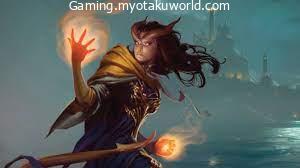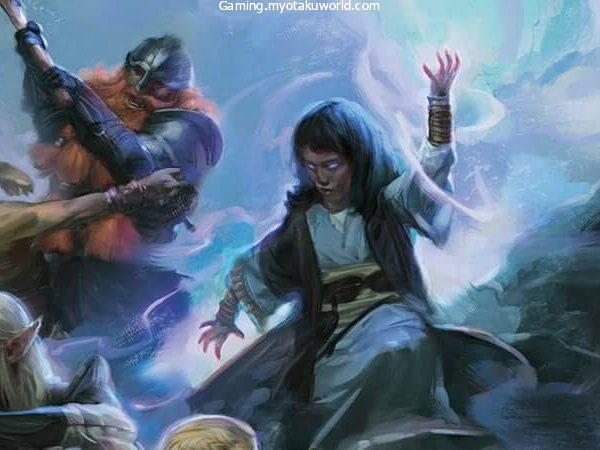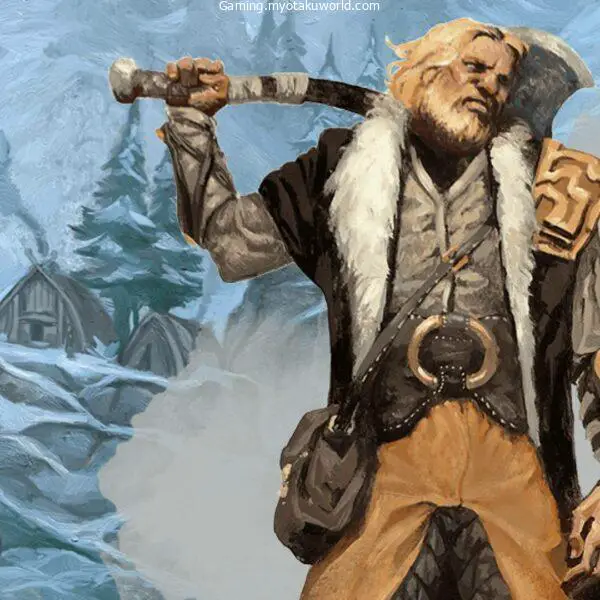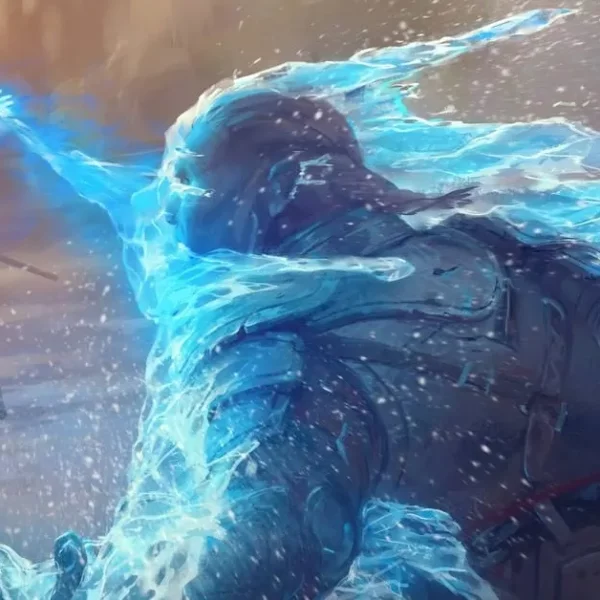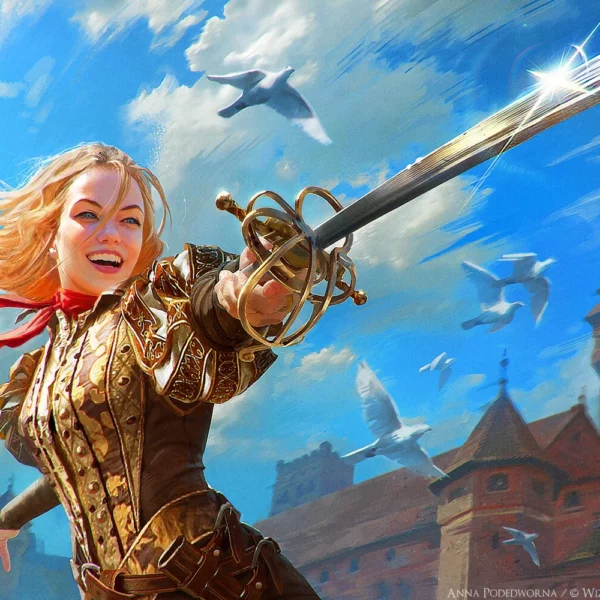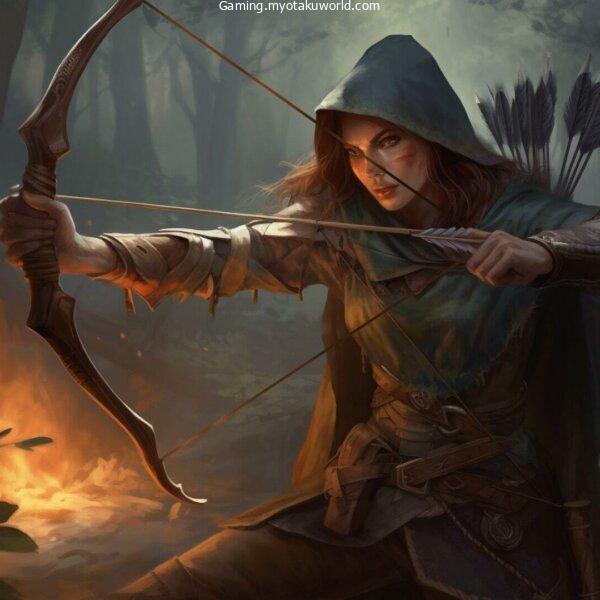The Warlock swears to an ancient, powerful force and draws its power from a mysterious master or mistress.
The Warlocks are an exceptional spellcasting class in Dungeons and Dragons 5e.
This guide will explain everything you need to know about Warlocks in D&D 5e. We’ll be covering the following:
What is Warlock in 5e?
The Player’s Handbook describes Warlocks as “seekers for the knowledge that lies concealed in the fabric of a multiverse.”
They are spellcasters in D&D 5e who draw their power from ancient knowledge and arcane secrets.
All Warlocks have a pact to an otherworldly entity known as the Warlock’s patron. This could be a deity similar to the relationship that a Cleric shares with their deity.
Warlocks don’t worship gods. Some Warlocks may be dedicated to demons, devils, or fey beings that are not usually associated with Clerics.
The relationship between the Warlocks and their patron is similar to that between a master-apprentice and a master.
The Warlock learns from the patron and draws power from them. However, they may sometimes have to do tasks for their patron.
The Dungeons and Dragons 3rd Edition was the first time Warlocks appeared.
They have been a very popular class among D&D players looking to be powerful spellcasters with a thirst for knowledge.
How to make a Warlock?
You will need to be careful about who your patron is and what pacts you make with them when creating a Warlock character in D&D 5e.
Below I will discuss Warlock patrons and pacts, but for now here are the basics of creating Warlocks.
Statistics on warlocks
Charisma is the primary statistic for Warlocks in D&D 5e. Charisma is the best stat to have if you want to be a Warlock. It is also a good idea to have Constitution as your second-highest stat.
Warlock characteristics
- What are the hit points Warlocks can get?
Warlocks start at 1st level with 8 hit points and a Constitution modifier. Warlocks receive an additional 1d8 hit point after their 1st level. - What armor are Warlocks allowed to wear?
While warlocks can wear any type of armor, they are proficient in light armor. - What weapons are Warlocks allowed to use?
Although warlocks can use all weapons, they are proficient in simple weapons. - In which saving throws can Warlocks be proficient?
Wisdom and Charisma. If your DM asks for you to save a throw, you can add your Wisdom modifier or Charisma modifier. - What skills does a Warlock have?
You can create a Warlock by choosing two of the following skills: Arcana and Deception, History. Intimidation. Investigation. Nature. - What equipment should Warlocks use?
All characters in D&D 5e come with starting equipment. All warlocks begin with a light Crossbow, 20 bolts OR any other simple weapon; a component pocket OR an arcane focal; a scholar’s bag OR a dungeoneer’s pack; and leather armour, any simple weapon and two daggers.
What is the Warlock’s Otherworldly Patron and what are their responsibilities?
Warlocks can choose an Otherworldly Patron at the 1st level to make a deal with. These confer special abilities at the 6th, 10th, and 14th levels.
Below are the Otherworldly Patrons, along with the benefits they grant.
The Archfey

Warlocks who select the Archfey to be their Otherworldly Patron swear to the lord or lady fey.
Fey beings are often mysterious or whimsical and can hold the secrets of old ages.
The Archfey patrons that are most common include the Prince of Frost, Queen of Air and Darkness and ruler of the Gloaming Court, Titania, of the Summer Court, Oberon, her consort, and Hyrsam the Prince of Fools.
Archfey Spells
Your Warlock can access the following spells if they make a pact to an Archfey:
- 1st level: faerie fire, sleep
- 2nd Level: calm emotions
- 3rd level: blink, plant growth
- 4th level: dominating beast, greater invisibility
- 5th level: dominant person, seeming
Archfey Features
The following special abilities are available to Warlocks who select an Archfey for their Otherworldly Patron:
- 1st Level: Fey Presence– You can project the fearsome or beguiling presence of the fey. This allows you to force creatures within 10ft of your location to make a Wisdom saving throw against the DC (difficulty) for your spell save DC. Creatures that fail are either charmed, or scared until the end your next turn. This feature can be used between short and long rests.
- 6th Level: Misty Escape– When you take damage, you can use your reaction to become invisible and to teleport to up to 60ft. Until you cast a spell or attack, you remain invisible.
- 10th Level: Beguiling Defences– If a creature attempts charm you, you may use your reaction against it to turn the charm against them. A Wisdom saving throw against your DC is required for the creature to be charmed.
- 14th Level: Dark Delirium– You can choose any creature within 60ft to make a Wisdom saving throw against the DC of your spell save DC. They are charmed/frightened for 1 minute by you if they fail. The creature is only able to see you and a misty world while being affected.
The Fiend

The Fiend is an evil devil of the lower planes who has evil goals, even though yours aren’t. These patrons want to destroy and corrupt all things, including you.
You might consider making a pact to demon lords like Orcus, Baphomet, Fraz’Urb–luu, and Demogorgon; archdevils like Asmodeus and Dispater; pit fiends; and especially mighty balors; and ultroloths or other lords from the yugoloths.
Fiend Spells
Your Warlock can make a pact to a Fiend and gain the following additional spells:
- 1st Level: Burning Hands, Command
- 2nd: deafness/blindness, scorching Ray
- 3rd Level: Fireball, Stinking Cloud
- 4th Level: Fire Shield, Wall of Fire
- 5th: flame striking, hallow
Fiend Features
The following special abilities are available to Warlocks who select the Fiend for their Otherworldly Patron:
- 1st Level: Dark One’s Boon– When you reduce hostile creatures to 0 hitpoints, you get temporary hit points equal in number to your Charisma modifier and your level.
- 6th Level: Dark One’s own Luck– This feature allows you to add a 10 to your ability check or saving throw. After seeing the outcome of the initial roll, you can do this.
- 10th Level: Fiendish Ressilience– You can choose from a variety of damage types to gain resistance after you have finished a long or short rest. This resistance is not available for silver and magic weapons.
- 14th Level: Hurl Through Hell- Once between short and long rests, you can hit a creature with an assault to transport them through the lower levels. If it isn’t a fiend, the target will reappearance from the lower planes at end of your next round and takes 10d10 psychic injury.
The Great Old One

The Great Old One, an ancient power that is far from reality, is often a being from either the Far Realm or one of the elder gods.
This being is a powerful and mysterious being with incomprehensible motives. Ghaunadar (or That Which Lurks); Tharizdun the Chained God; Dendar the Night Serpent; Zargon the Returner; Great Cthulhu, and other unfathomable beings are some of the most common patrons of Warlocks who choose to become the Great Old One.
Amazing Old One Spells
Your Warlock can access the following spells if they make a pact to a Great Old One:
- 1st Level: dissonant Whispers, Tasha’s hideous laughter
- Second level: detect thoughts and phantasmal force
- 3rd Level: clairvoyance
- 4th level: dominant beast, Evard’s black tentacles
- 5th level: dominate person, telekinesis
Amazing Old One Features
The following special abilities are available to Warlocks who select a Great Old One for their Otherworldly Patron:
- 1st Level: Awakened Mind– You can communicate telepathically to any creature within 30ft of your location. Although the creature doesn’t need to speak your language, it must understand at least one.
- 6th Level: Entropic Ward– You can use your reaction to give a creature disadvantage on their attack roll. You can still make an attack roll against the creature if it fails to attack you, provided it occurs before your next turn.
- 10th Level: Thought Shield– Your thoughts can’t be read and you are immune to pyschic injury. You take psychic damage if a creature attacks you.
- 14th Level: Create Thrall– You can touch an incapable humanoid, charmthem, and communicate telepathically to them. You can remove this charm only with a Remove Cursespell. This is done when the charm condition is removed or if the feature is used again.
What are the Warlock Pacts and how do they work?

The Warlock’s Otherworldly patron bestows a gift to them at the 3rd level. The following Pact magic features are available to Warlocks:
Pact of the Chain
They can be learned and used to cast a spell.
This spell does not count towards the number of You are familiar with the following spells.
You can cast the spell on any of your familiars, such as a bat or cat or a spider or owl or you can choose one from the special forms imp or pseudodragon or quasit.
You can give up one of your attacks when you take the Attack action to let your familiar make its own attack.
Pact of the Blade
An action can be used to create Pact weapons in your empty hands. This is a melee weapon that you choose and you become proficient in it.
The Pact weapon is magical and can be used to overcome resistance and immunity to damage and nonmagical attacks.
If the Pact weapon is within 5ft of you for more than 1 minute, it will disappear.
Pact of the Tome
A Book of Shadows is a book that your patron gives to you.
You can choose up to three cantrips from any spell list. You can still cast cantrips while the book is on you.
They do not count towards your total number of cantrips.
What are the Eldritch Invocations of the Warlock?
The Eldritch Invocations are bits of forbidden knowledge that Warlocks have the ability to use to increase their magical abilities and strengthen their spells.
Warlocks have two options for eldritch invocations at the 2nd level. As they progress, they can select more.
Some eldritch Invocations require prerequisites, such as a Pact choice or a certain level. These are the Player’s Handbook eldritch Invocations:
- Agonizing Blaster – The damage from the spell is increased by your Charisma modifier. Prerequisite: The eldritch blast must trip.
- Armor of Shadows – You can cast mage armour on yourself at will.
- Ascendant – You have the ability to cast levitate on yourself at will. Prerequisite: 9th level.
- Beast Speech– You can speak with animals at will.
- Beguiling Influence– You will gain proficiency in deception and persuasion.
- Bewitching Whispers– You can cast Compulsion once in between long rests by using a spell slots. Prerequisite: 7th level.
- Book of Ancient Secrets– You can add ritual spells to your Book of Shadows, but they will not count against your existing spells. Prerequisite: Use Pact of the Tome.
- Chains of Caracei- You can cast hold beast at will, but only one time on any type of creature between long rests. Prerequisites: 15th level, Pact of the Chain.
- The Devil’s Sight– You can see normal in both magical and non-magical darkness from up to 120ft.
- Dreadful Word– You can use a spell slot to cast confusion once you have taken long breaks. Prerequisite: 7th level.
- Eldritch sight– You have the ability to cast detect magic at will.
- Eldritch Spear– The range of the Eldritch Blast is 300ft. Prerequisite: cantrip .
- Eyes of the Rune Keeper– You can read all writing.
- Fiendish Vigor– You can cast false lives at will.
- The Gaze of Two Minds– You can use your action and touch a willing humanoid to perceive through its senses until your next turn.
- Life drinker-When you strike a creature using your Pact weapon they take additional necrotic damage equaling your Charisma modifier. Prerequisites: 12th level, Pact of the Blade.
- Mask of Many Faces-You can make any disguise you want
- Master in Myriad Forms– You have the ability to cast alter yourself at will. Prerequisite: 15th level.
- Minions Of Chaos– You can cast conjure elements using a spell slot once in between long rests. Prerequisite: 9th level.
- Mire The Mind– You can cast slow once in between long rests using a spell slot. Prerequisite: 5th level.
- Misty Visions– You can create a silent image at will.
- One With Shadows– If you are in dim light or darkness, your actions can make you invisible until you move or perform an action. Prerequisite: 5th level.
- Otherworldly Leap– You can do jump on yourself. Prerequisite: 9th level.
- Repelling Blaster– You can push a creature 10ft away if you hit them with an Eldritch Blast. Prerequisite: eldritch blast musttrip .
- Sculptor– You can cast using a spell slot, once you have taken a long break. Prerequisite: 7th level.
- Sign Of Ill Omen– You can cast curse using a spell slot once in between long rests. Prerequisite: 5th level.
- Thief Of Five Fates– You can cast bane once in between long rests.
- Thirsting blade– When you use your Pact weapon to attack, you can attack twice as often as once. Prerequisite: 5th Level, Pact of the Blade
- Visions of Distant Realms– You can cast an Arcane Eye at will. Prerequisite: 15th level.
- Voice Of The Chain Master– You can communicate with your familiar telepathically, see through their eyes, and speak through them using your own voice. Prerequisite: Pact of the Chain.
- Whispers of the Grave– You can speak with the dead at will. Prerequisite: 9th level.
- Witch sight– This allows you to see the true form and appearance of any shapechanger, or any creature that is hidden with an illusion or transmutation. It can be seen within 30 feet. Prerequisite: 15th level.
What are the Warlock spells of 5e?
Warlocks have the ability to learn base spells and cantrips as they gain spells through patrons or eldritch invocations.
You can find the Player’s Handbook full list of Warlock cantrips, but this is a list with the top Warlock spells for 5e.
- Eldritch blast (cantrip)– Make a ranged attack against the target at 120ft. The target takes 1d10 damage upon a hit.
- (1st level)- A curse is placed on any creature you see within your range. You deal additional 1d6 damage to the target every time you attack it until the spell ends. When casting the spell, you can choose one ability. Ability checks with the selected ability result in the target being handicapped.
- Invisibility (second level)– You or a creature that you touch become invisible until the spell ends (1hr or when the creature attacks or casts spells). Any item the target is carrying or wearing is invisible as long as it’s on his person.
- Counterspell (3rd level reaction)-You try to stop a creature from casting a spell. The spell is invalid if it casts a spell lower than 3rd level. Make sure your spellcasting ability is checked if the creature is casting spells of 4th or higher levels. The DC equals 10 + your spell’s level. If the spell succeeds, the effect of the creature’s magic is null.
FAQs
What race should I choose for a Warlock?
A great Warlock is any race that receives a Charisma bonus. These include tieflings and half-elves. Warlocks are also a good choice for humans.
What background should I choose for a Warlock?
The following backgrounds are suitable for Warlocks: Sage, Hermit, and Noble.
Are Warlocks good at in 5e?
D&D players often claim that Warlocks have less power than Wizards and Sorcerers. They have one spell slot at the 1st level, but they have fewer spell slots. Warlocks, unlike Wizards and Sorcerers, have their spell slots returned after a short rest or long rest. Additionally, Warlocks are more powerful than Sorcerers or Wizards in combat, especially if they are built around their eldritch blast cantrip and hex spell and Agonizing Blaster invocation.
Final Words
The Warlock class is one of the most popular for roleplaying in D&D 5e.
Their otherworldly pact gives them a rich backstory and opens up many possibilities for future events.
They aren’t as keen on combat as other spellcasters, even though they are powerful.
For a complete breakdown of spells, patrons, and pacts, make sure you get the Dungeons & Dragons Player’s Handbook if you’re serious about playing a Warlock 5e.
